This CE Center article is no longer eligible for receiving credits.
Architectural Evolution
The importance of spatial uniformity in the masking sound (i.e. achieving tight tuning tolerances throughout the space) is also emphasized by the evolution of sound masking architecture. Since the technology was first introduced in the 1960s, numerous advancements have been made in order to make tuning a more precise and efficient exercise.
Centralized Sound Masking
The earliest sound masking systems used a centralized architecture. The name derives from the fact that the electronic components used to generate the masking sound, as well as to provide volume and frequency control and amplification, are all located within an equipment room or closet. The settings established at this central point are broadcast over a large number of loudspeakers—sometimes as many as hundreds. While most offer limited analog volume control at each loudspeaker (usually four to five settings, in 3 dBA steps), their centralized design means that large areas of the facility are nonetheless served by a single set of output settings with little or no option for local adjustment.

Image courtesy of K.R. Moeller Associates Ltd.
A centralized masking architecture consists of a centrally located rack of electronic equipment that is used for sound generation, volume, and frequency adjustment. This equipment is connected to a large number of loudspeakers—as few as eight, or as many as hundreds—forming a single adjustment zone.
Because the technician cannot make precise volume changes in specific areas, he or she has to set each large zone (i.e. individually controllable groups of loudspeakers) to a level that is best ‘on average.’ Due to variations in the acoustic conditions across the space and the impact of interior elements, the masking sound is too low in some areas and too high in others. If the technician raises the volume to address a performance deficiency in one area, the sheer size of the zone means the volume simultaneously increases in others, affecting occupant comfort. If the technician lowers it to boost comfort, speech privacy and noise control is sacrificed. This pattern repeats at unpredictable points across the space, which is why central system specifications typically allow large variations in overall masking volume. Tolerance is typically 4 to 6 decibels (i.e. ±2 to 3 dBA). Furthermore, centralized architecture only provides a global frequency control for each large zone.
Centralized architectures are also prone to a phenomenon called phasing, or noticeable variations in the masking level. In order to try to avoid this problem, technicians employ a dual-channel, interlaced design, ensuring that adjacent loudspeakers do not emit the same masking signal; however, it requires two sets of centrally-located electronic equipment per zone, raising costs.
Decentralized sound masking
Decentralized architecture emerged in the mid-1970s in order to address a major deficiency in the ability to tune centralized systems: large zone size. Rather than locating sound generation, volume, and frequency control in a central location, the electronics required for these functions are integrated into ‘master’ loudspeakers, which are distributed throughout the facility—hence the ‘decentralized’ name.

Image courtesy of K.R. Moeller Associates Ltd.
A decentralized masking architecture uses ‘master’ loudspeakers to house the electronics needed for sound generation, volume, and contour control. Adjustment zones are one to three loudspeakers in size. Local changes are made using a screwdriver or remote control.
Each ‘master’ is connected to up to two ‘satellite’ loudspeakers, which repeat their settings. Therefore, a decentralized system’s zones are only one to three loudspeakers in size (i.e. 225 to 675 ft2 [30 to 62 m2]). This distributed design inherently controls phasing. In addition, because each small zone offers fine volume control, local variations can addressed, allowing more consistent and, hence, effective masking levels to be achieved across a facility. However, there are still limits to the adjustments that can be made with respect to frequency, which impacts performance.
Furthermore, a technician must make changes directly at each ‘master’ loudspeaker, using either a screwdriver (i.e. with analog controls) or an infrared remote (i.e. with digital controls), making future adjustments challenging. It is advisable to measure performance and modify a sound masking system’s settings when changes are made to the physical characteristics of the space (e.g. furnishings, partitions, ceiling, flooring) or to occupancy (e.g. relocating a call center or human resource functions into an area formerly occupied by accounting staff). The likelihood that these types of change will occur during a sound masking system’s 10- to 20-year lifespan is almost certain; therefore, one cannot take a ‘set-it-and-forget-it’ approach. Engineers needed to develop a more practical way of adjusting the masking sound.
Networked sound masking
The first networked sound masking system was introduced just more than a decade ago. This technology leverages the benefits of decentralized electronics, but networks the system’s components together throughout the facility—or across multiple facilities—in order to provide centralized control of all functions via a control panel and/or software. Changes can also quickly be made following renovations, moving furniture or personnel, maintaining masking performance within the space without disrupting operations.

Image courtesy of K.R. Moeller Associates Ltd.
A networked masking architecture uses ‘hubs’ to house the electronics required for sound generation, volume, and frequency control. Adjustment zones are one to three loudspeakers in size. All local and global changes, including those to zoning, are made from a central location, such as a small panel or software application.
When designed with small zones of one to three loudspeakers offering fine volume (i.e. 0.5 dBA) and frequency (i.e. 1/3 octave) control, networked architecture can provide consistency in the overall masking volume not exceeding ±0.5 dBA, as well as highly consistent masking spectrums, yielding much better tuning results than possible with previous architectures. Some networked sound masking systems can also be automatically tuned using a computer, which first measures the sound and then rapidly adjusts the masking output to match the specified curve.
Today, there are a number of different product offerings within the centralized, decentralized, and networked categories. Some vendors have also utilized a hybrid design, implementing a decentralized architecture in closed rooms (e.g. private offices) and a centralized architecture in the open plan. However, it should be noted that the centralized architecture presents significant tuning challenges in the type of area where occupants are likely to rely on masking the most for speech privacy and noise control.
Sound masking systems are a common component of today’s interiors, from their original use in commercial offices to relatively newer applications such as patient rooms in hospitals.
This technology uses loudspeakers to distribute an engineered background sound throughout a facility, raising its ambient level in a controlled fashion. The new level obscures noises that are lower in volume and reduces the disruptive impact of those that are higher by minimizing the degree of change perceived by listeners. Similarly, conversations are either entirely covered up or their intelligibility is reduced, improving speech privacy and decreasing the number of disruptions to occupants’ concentration.
Most people have experienced this type of effect—for example, when washing dishes at the kitchen sink while trying to talk to someone in the next room. The listener can tell the other person is speaking, but it is difficult to understand exactly what is being said because the running water has raised the ambient level in their area. In fact, everyday examples are virtually endless: the drone of an airplane engine, the murmur of a crowd in a busy restaurant, or even the rustling of leaves in the wind. They all have the potential to mask sounds the listener would otherwise hear.
Of course, when introducing a sound to a workplace or a healthcare facility, it is vital to ensure that it is as comfortable and unobtrusive as possible. Otherwise, it risks becoming a source of irritation and rather than helping to solve an acoustic problem, it becomes one itself—as was the case with the original masking systems developed in the late 1960s, which used white noise generators.

Photo courtesy of K.R. Moeller Associates Ltd.
White and Pink Noise
Though the term ‘white noise’ still tends to be used interchangeably with ‘sound masking,’ it is a very different type of sound from that produced by modern masking technologies.
White noise is a random broadband sound—meaning it includes a wide range of frequencies—that typically spans the audible range of 20 to 20,000 hertz (Hz). Graphical representations of this type of noise vary depending on the horizontal axis. If it shows individual frequencies, volume is constant; however, if the scale is in octaves, each octave’s volume increases by three decibels (dB) because each octave contains double the number of frequencies than the one before it, and as a general rule, the combined volume of any two sounds of equal volume is three dB higher. Thus, a graph depicting white noise shows either flat or increasing volume.
Most people describe white noise as ‘static’ with an uncomfortable, hissing quality. Those old enough to remember analog televisions compare it to the ‘snow’ broadcast when the antenna lost the transmission signal and picked up electromagnetic noise instead. It is unsurprising that these early masking systems were typically turned down or off soon after they were installed.
‘Pink noise’ is another term often inaccurately substituted for ‘sound masking.’ It is also a random broadband sound, but instead of being equal in volume at each frequency, volume decreases at a rate of three dB per octave as frequency increases. However, because these decreases are offset by the increases created by the doubling of frequencies in each octave, pink noise is constant in volume per octave. Subjectively speaking, this sound is less hissy than white noise. On the other hand, the relatively louder low frequencies give it a rumbling quality, prompting comparisons to the sound of a waterfall.
Given these descriptions, it is understandable why modern sound masking systems do not emit white or pink noise, or in fact any of the other colors (e.g. brown, blue or purple).
A Sound Masking Spectrum
A sound masking spectrum—often called a ‘curve’—is engineered to balance effective acoustic control and comfort. It is usually provided by an acoustician or an independent party, such as the National Research Council (NRC), rather than by the masking vendor.
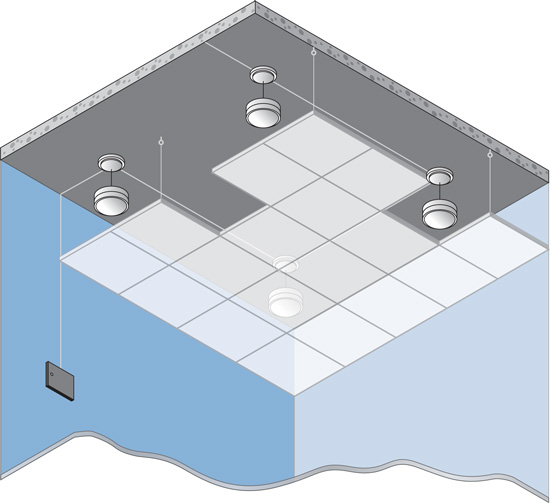
Image courtesy of Screen Solutions
A sound masking system consists of a series of loudspeakers, which distribute an engineered background sound throughout a facility. The loudspeakers can be installed above a suspended ceiling (as shown) or in an open ceiling.
A masking curve includes a wide range of randomly generated frequencies; however, it is narrower than the full audible range—typically from at least 100 to 5,000 Hz, and sometimes as high as 10,000 Hz. Further, the volume of masking frequencies is not equal, nor do they decrease at a constant rate as frequency increases.
It is important to understand that the curve defines what the sound masking system’s measured output should be within the space. Regardless of how the system is designed, its out-of-the-box settings, or the orientation of its loudspeakers (i.e. upward- or downward-facing, sometimes called ‘direct-field’), the sound is influenced as it interacts with various interior elements within the facility, such as the layout and furnishings. If the sound is to meet the specified curve, the system’s volume and frequency settings have to be adjusted in small, localized zones. In other words, it must be tuned for the particular environment in which it is installed.
Tuning is handled by a qualified technician after the ceilings and all furnishings are in place, and with mechanical systems operating at normal daytime levels. Since conversations and activities can prevent accurate measurement, it is done prior to occupation or after hours. Basically, the technician uses a sound level meter to measure the masking sound at ear height. The technician analyzes the results, and adjusts the system’s volume and equalizer controls accordingly. This process is then repeated as often as needed until the desired curve is met at each tuning location.
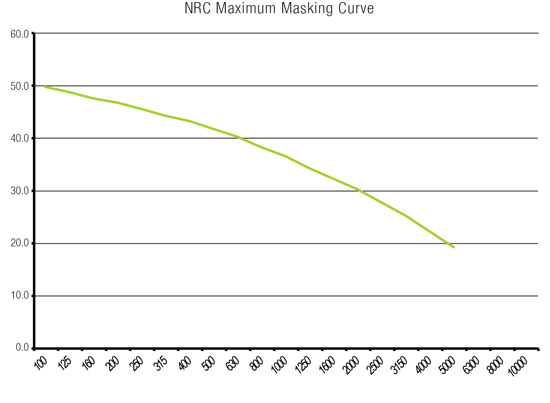
Image courtesy of NRC
A sound masking spectrum or ‘curve’ is typically specified by an acoustician or supplied by an independent third party, such as the National Research Council (as shown), rather than by the sound masking system’s vendor.
Achieving Spatial Uniformity
Most people compare the sound of a professionally tuned masking system to that of softly blowing air. However, there is much more significance to the tuning process than simply providing a pleasant auditory experience. One must also ensure that the sound performs its intended job.
The effectiveness of the masking sound is directly related to the sound masking system’s ability to closely match the specified curve. Some degree of variation is expected; it is impossible to achieve perfection in every tuning location. However, because variations in the masking sound can profoundly impact performance, the specification should not only provide a target curve, but also a ‘tolerance’ that indicates by how much the sound is allowed to deviate from that curve across the space. Achieving consistency is also important for comfort; a uniform sound fades into the background more easily, and occupants come to consider it a natural part of their space.
Historically, tolerance was often set to ±2 dBA (i.e. plus or minus two A-weighted decibels), giving an overall range of 4 dBA. However, such wide swings in overall volume across the space can allow occupants to understand up to 43 percent more of a conversation in some areas than they can in others.
Advances in masking technology now permit tolerance to be set as low as ±0.5 dBA (i.e. a range of 1 dBA), yielding far more consistent results and providing dependable masking coverage throughout the installation.
Measuring the Impact
Articulation Index (AI) tests conducted between two workstations illustrate the importance of keeping tolerance as low as possible and consistently meeting the specified sound masking curve throughout the facility.
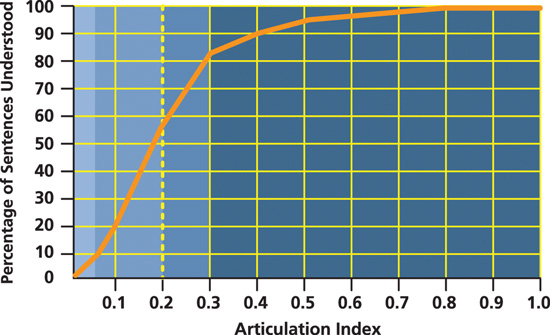
Image courtesy of K.R. Moeller Associates Ltd.
The relationship between Articulation Index (AI) and intelligibility is not linear. For example, a value of 0.5 means a listener can understand approximately 95 percent of a conversation, not 50 percent. A very low AI value is required for true privacy.
To calculate AI, one uses a test signal that includes the frequencies known to specifically impact speech comprehension. This signal is measured at 1 meter from the ‘source’ and again at the ‘listener’ location. The background sound level is also measured at the ‘listener’ location in order to quantify how loud the test signal is relative to it—a value known as the signal-to-noise ratio (SNR). This value is critical, because the lower the SNR, the less the intelligibility and the greater the speech privacy. For AI, SNR is measured in each of 15 frequency ranges (from 200 to 5,000 Hz). Each of these ranges is weighted according to the degree to which it contributes to speech comprehension. The final AI value ranges from 0 (where conversation is completely unintelligible) to 1.0 (where everything is heard and understood).
In this case study, the occupants sit approximately 15.5 feet (4.7 meters) apart within an open plan (Figure 1). The partitions are 64 inches (1.6 meters) in height, and the ceiling tile is highly absorptive. However, without sound masking, the ambient level is only 40.6 dBA, and the listener can understand 85 percent of the other person’s conversation. When masking is applied, comprehension quickly declines. In fact, for each decibel of increase in masking volume, comprehension drops by an average of 10 percent (Figure 2). With the masking set to 48 dBA (i.e. the typical maximum level for comfort) with a narrow tolerance of ±0.5 dBA, the listener can understand just 14 to 25 percent. When a broader tolerance of ±2 dBA is applied, they can understand up to 59 percent—barely an improvement over the unmasked conditions.
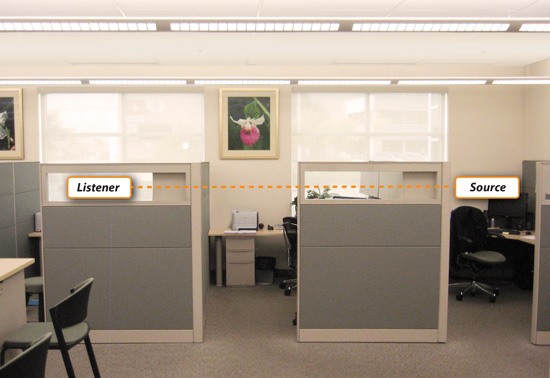
Photo courtesy of K.R. Moeller Associates Ltd.
Figure 1: Articulation Index (AI) tests were conducted between these two workstations to illustrate the impact tuning tolerances have on sound masking’s ability to improve speech privacy and, hence, the importance of closely and consistently meeting the specified sound masking spectrum or curve throughout the facility.
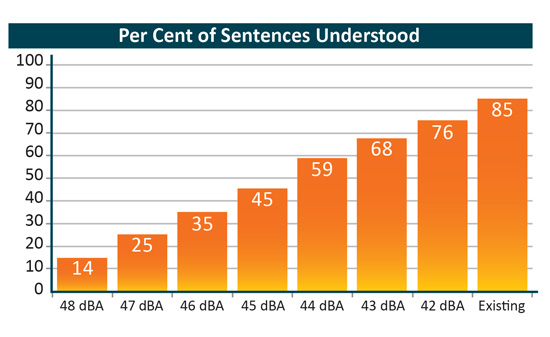
Image courtesy of K.R. Moeller Associates Ltd.
Figure 2: Though a small amount of deviation is unavoidable, the Articulation Index tests show that too broad a tolerance (e.g. of ±2 dBA) represents more than a 40 percent drop in sound masking performance. A tight tolerance of ±0.5 dBA ensures the masking effect is consistently experienced across the space.
Though this example focuses solely on volume, variations in frequencies can similarly impact masking performance.
A lack of acoustic privacy carries real risk, particularly in facilities where there is a perceived need for it or an expectation on the part of its users. Examples that readily spring to mind include hospitals, bank branches, law offices, government, and military facilities. However, other types of spaces—such as commercial offices, call centers, and hotels, to name but a few—have privacy needs as well. The degree required typically depends on the type of activities the space hosts.
In some countries, protecting verbal communication within particular types of facilities is actually mandated by law. The Health Insurance Portability and Accountability Act (HIPAA) introduced by the U.S. Department of Health and Human Services in 1996 is a good example. It requires healthcare entities to take “reasonable safeguards” to ensure speech privacy during both in-person and telephone conversations with patients and between employees.
Acoustic privacy is also vital to employees’ overall satisfaction with their workplace. A decade-long survey of 65,000 people run by the Center for the Built Environment (CBE), University of California, Berkeley, found that lack of speech privacy is the number-one complaint in offices. Participants expressed irritation at being able to overhear in-person and telephone communications, as well as concern for their own level of privacy.

Image © iStockphoto.com/kupicoo
Studies show that employees spend the majority of their time on individual focus work. Speech privacy and noise control are vital to concentration and workplace satisfaction.
The topic of workplace satisfaction also emphasizes the need to consider those occupying spaces other than closed rooms. Though some may dismiss the importance of acoustic privacy when designing an open plan, studies show that it has a significant impact on productivity. For instance, research conducted by Finland’s Institute of Occupational Health shows that unwilling listeners demonstrate a five to 10 percent decline in performance when undertaking tasks such as reading, writing, and other forms of creative work. Simply hearing that someone is speaking can disturb concentration, but this problem is greatly magnified when you can clearly understand what they are saying because, if you can follow a conversation, it is much harder to ignore it.
Though an organization might not consider privacy a goal within an open plan, it is impossible to justify increasing disruptions. Taking the steps required to lower speech intelligibility within this type of space increases occupants’ output and reduces error rates.
Architectural Evolution
The importance of spatial uniformity in the masking sound (i.e. achieving tight tuning tolerances throughout the space) is also emphasized by the evolution of sound masking architecture. Since the technology was first introduced in the 1960s, numerous advancements have been made in order to make tuning a more precise and efficient exercise.
Centralized Sound Masking
The earliest sound masking systems used a centralized architecture. The name derives from the fact that the electronic components used to generate the masking sound, as well as to provide volume and frequency control and amplification, are all located within an equipment room or closet. The settings established at this central point are broadcast over a large number of loudspeakers—sometimes as many as hundreds. While most offer limited analog volume control at each loudspeaker (usually four to five settings, in 3 dBA steps), their centralized design means that large areas of the facility are nonetheless served by a single set of output settings with little or no option for local adjustment.

Image courtesy of K.R. Moeller Associates Ltd.
A centralized masking architecture consists of a centrally located rack of electronic equipment that is used for sound generation, volume, and frequency adjustment. This equipment is connected to a large number of loudspeakers—as few as eight, or as many as hundreds—forming a single adjustment zone.
Because the technician cannot make precise volume changes in specific areas, he or she has to set each large zone (i.e. individually controllable groups of loudspeakers) to a level that is best ‘on average.’ Due to variations in the acoustic conditions across the space and the impact of interior elements, the masking sound is too low in some areas and too high in others. If the technician raises the volume to address a performance deficiency in one area, the sheer size of the zone means the volume simultaneously increases in others, affecting occupant comfort. If the technician lowers it to boost comfort, speech privacy and noise control is sacrificed. This pattern repeats at unpredictable points across the space, which is why central system specifications typically allow large variations in overall masking volume. Tolerance is typically 4 to 6 decibels (i.e. ±2 to 3 dBA). Furthermore, centralized architecture only provides a global frequency control for each large zone.
Centralized architectures are also prone to a phenomenon called phasing, or noticeable variations in the masking level. In order to try to avoid this problem, technicians employ a dual-channel, interlaced design, ensuring that adjacent loudspeakers do not emit the same masking signal; however, it requires two sets of centrally-located electronic equipment per zone, raising costs.
Decentralized sound masking
Decentralized architecture emerged in the mid-1970s in order to address a major deficiency in the ability to tune centralized systems: large zone size. Rather than locating sound generation, volume, and frequency control in a central location, the electronics required for these functions are integrated into ‘master’ loudspeakers, which are distributed throughout the facility—hence the ‘decentralized’ name.

Image courtesy of K.R. Moeller Associates Ltd.
A decentralized masking architecture uses ‘master’ loudspeakers to house the electronics needed for sound generation, volume, and contour control. Adjustment zones are one to three loudspeakers in size. Local changes are made using a screwdriver or remote control.
Each ‘master’ is connected to up to two ‘satellite’ loudspeakers, which repeat their settings. Therefore, a decentralized system’s zones are only one to three loudspeakers in size (i.e. 225 to 675 ft2 [30 to 62 m2]). This distributed design inherently controls phasing. In addition, because each small zone offers fine volume control, local variations can addressed, allowing more consistent and, hence, effective masking levels to be achieved across a facility. However, there are still limits to the adjustments that can be made with respect to frequency, which impacts performance.
Furthermore, a technician must make changes directly at each ‘master’ loudspeaker, using either a screwdriver (i.e. with analog controls) or an infrared remote (i.e. with digital controls), making future adjustments challenging. It is advisable to measure performance and modify a sound masking system’s settings when changes are made to the physical characteristics of the space (e.g. furnishings, partitions, ceiling, flooring) or to occupancy (e.g. relocating a call center or human resource functions into an area formerly occupied by accounting staff). The likelihood that these types of change will occur during a sound masking system’s 10- to 20-year lifespan is almost certain; therefore, one cannot take a ‘set-it-and-forget-it’ approach. Engineers needed to develop a more practical way of adjusting the masking sound.
Networked sound masking
The first networked sound masking system was introduced just more than a decade ago. This technology leverages the benefits of decentralized electronics, but networks the system’s components together throughout the facility—or across multiple facilities—in order to provide centralized control of all functions via a control panel and/or software. Changes can also quickly be made following renovations, moving furniture or personnel, maintaining masking performance within the space without disrupting operations.

Image courtesy of K.R. Moeller Associates Ltd.
A networked masking architecture uses ‘hubs’ to house the electronics required for sound generation, volume, and frequency control. Adjustment zones are one to three loudspeakers in size. All local and global changes, including those to zoning, are made from a central location, such as a small panel or software application.
When designed with small zones of one to three loudspeakers offering fine volume (i.e. 0.5 dBA) and frequency (i.e. 1/3 octave) control, networked architecture can provide consistency in the overall masking volume not exceeding ±0.5 dBA, as well as highly consistent masking spectrums, yielding much better tuning results than possible with previous architectures. Some networked sound masking systems can also be automatically tuned using a computer, which first measures the sound and then rapidly adjusts the masking output to match the specified curve.
Today, there are a number of different product offerings within the centralized, decentralized, and networked categories. Some vendors have also utilized a hybrid design, implementing a decentralized architecture in closed rooms (e.g. private offices) and a centralized architecture in the open plan. However, it should be noted that the centralized architecture presents significant tuning challenges in the type of area where occupants are likely to rely on masking the most for speech privacy and noise control.
Updating Performance Standards
Sound masking is a critical design element for which one does not want to leave a lot of room for error. That is why ASTM Subcommittee E33.02 on Speech Privacy—part of ASTM Committee E33 on Building and Environmental Acoustics—is currently working on proposed standard WK47433, Performance Specification of Electronic Sound Masking When Used in Building Spaces. They are also in the process of updating:
• ASTM E1130, Test Method for Objective Measurement of Speech Privacy in Open Plan Spaces Using Articulation Index;
• ASTM E1374, Guide for Open Office Acoustics and Applicable ASTM Standards;
• ASTM E1573, Test Method for Evaluating Masking Sound in Open Offices Using A-Weighted and One-Third Octave Band Sound Pressure Levels; and
• ASTM E2638, Test Method for Objective Measurement of the Speech Privacy Provided by a Closed Room.
Preparing a Performance-Based Spec
Indeed, without a set of performance standards, the user may not achieve the expected level of speech privacy, noise control and occupant comfort.
Preparing or even evaluating a sound masking specification can be challenging, but the payoff is worth the effort. These systems typically have a long lifespan. When properly designed, they help to keep acoustics under control even as densities swell and, if included in a project’s planning stages, they also increase flexibility, typically allowing an organization to remain in their facility for a longer period. In other words, the user can end up living with the system for quite some time.
Currently, sound masking systems are often specified according to the aforementioned types—centralized, decentralized, or networked—limiting the number of vendors that can bid on a given project. Bidding opportunities are further restricted when the specification incorporates proprietary elements, such as the dimensions of components, types of inputs/outputs, and other minor details. At the other end of this spectrum are specifications that merely state “provide a sound masking system.” When compared to the manner in which most other building systems such a HVAC or fire alarms are specified, the contrast is striking.
The best approach is to focus on the six qualities that are critical to effectiveness, comfort, and flexibility. Whether one’s role is to write the specification or evaluate an existing document, these performance-based factors provide a solid foundation for a successful sound masking installation in any type of facility:
• Adjustment zone size
• Masking sound generation
• Volume adjustment
• Frequency adjustment
• Loudspeaker requirements
• Measured results
With these six factors forming the framework for the document, one can easily add other requirements, the importance of which varies by project (e.g. the appearance of the loudspeakers in an open ceiling), application (e.g. individual room control in a hospital patient room) or geographical region (e.g. UL 2043 compliance in the United States).
Adjustment zone size
To recap, adjustment zones are groups of loudspeakers for which the technician can establish individual volume and frequency settings. From a performance perspective, one loudspeaker in each zone is ideal, but it can be an acceptable compromise—and more budget-friendly—to have up to three, at least across open plans. In fact, most systems use a mix of these small zone sizes.
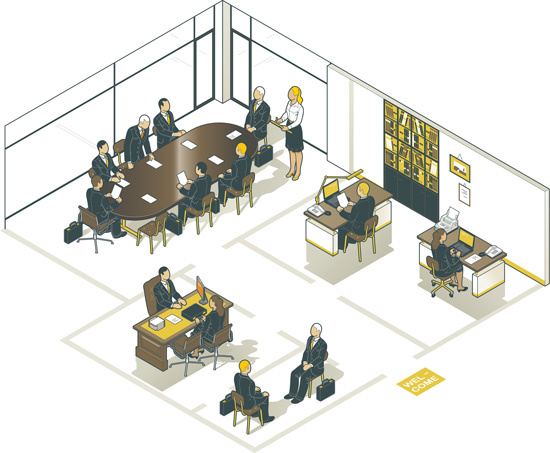
Image © iStockphoto.com/Peter Willems
Acoustic conditions and user needs vary across each facility, including open plans. Small zones allow the system to be tuned to provide a consistent masking sound, speech privacy, and noise control across the entire installation.
Acoustic conditions and user needs vary between private offices, meeting rooms, corridors, and reception areas, as well as across open plans. Designs that use large adjustment zones (e.g. involving more than a few loudspeakers) require one to make ever-increasing compromises. For example, if the volume needs to be raised to improve the system’s effectiveness in one area, it might be too loud in another, affecting comfort. If comfort is desired, the masking’s effectiveness may be diminished in some areas. Furthermore, as shown in the graph, the larger the zone, the greater the number of occupants it affects. The numbers ramp up very quickly, from an average of 1.3 people in a single loudspeaker zone to literally hundreds of people and tens of thousands of square feet in a hundred loudspeaker zone.

Image courtesy of K.R. Moeller Associates Ltd.
The greater the number of loudspeakers within each adjustment zone, the larger the area of compromise between masking effectiveness and occupant comfort, and the greater the number of people affected by those compromises.
Zone size also affects the ease with which the technician can make changes in response to, for example, renovations or moving personnel. Large zones require the system’s design to be altered, which usually involves moving loudspeakers and rewiring.
In this case, less truly is more: one to three loudspeakers in each zone (i.e. 225 to 675 ft2 [30 to 62 m2]) provides a high degree of control and flexibility, enabling technicians to adjust their volume and frequency to achieve a consistently effective and comfortable masking sound.
Masking sound generation
Each small adjustment zone should feature a dedicated masking sound generator in order to avoid a phenomenon called phasing (i.e. uncontrollable variations in the masking levels).
To maximize unobtrusiveness, each generator should also provide a sound that occupants perceive as random (i.e. with no noticeable repeat cycle). If there is no noticeable loop, and the masking can also be finely tuned to suit the needs found throughout the space, occupants do not focus on the sound.
The sound produced by the generator should cover the entire masking spectrum of 100 to 5,000 Hz or as high as 10,000 Hz.
Volume Adjustment
The workplace design, furnishings, and other materials used within it will impact the masking sound regardless of how the loudspeakers are installed. For this reason, the ASTM standard for measuring and evaluating masking performance in open offices (i.e. ASTM E1573, Test Method for Evaluating Masking Sound in Open Offices Using A-Weighted and One-Third Octave Band Sound Pressure Levels) requires measurements to be taken in areas that are representative of all workspace types.
If the zones are large, many loudspeakers are set to the same volume setting, but the masking nonetheless fluctuates across the space as it interacts with the variables mentioned above. Some centralized designs try to mitigate this problem by providing audio transformers on each loudspeaker; however, they only offer coarse adjustments in 3 dBA steps.
When the masking volume cannot be finely adjusted in small areas, the technician needs to set it to a level that is best ‘on average,’ compromising comfort or effectiveness at various unpredictable points across the space. Users can typically expect a 10 percent reduction in performance for each decibel below the target masking volume. A poorly designed system can allow as much as 4 to 6 dBA variation, halving the system’s effectiveness in some areas. Furthermore, these peaks and troughs call occupants’ attention to the sound as they move through the space.
The sound masking system’s performance is further reduced if it must be tuned to a lower overall volume in order to avoid exceeding the typically recommended maximum of 48 dBA in some areas.
Therefore, the spec should call for fine volume control for each small zone of one to three loudspeakers. Increments of 0.5 dB enable adjustment wherever needed in order to accommodate variable acoustic conditions. Also require the final masking volume to be consistent within a range of 1 dBA or less in all areas desired. Again, the benefits are comfort and consistent performance across the space.
Frequency Adjustment
The system should provide fine frequency control for each small adjustment zone. The range of masking sound is generally specified to be between 100 to 5,000 Hz or as high as 10,000 Hz. The system should provide control over these frequencies via third-octave adjustment, because it is both the industry standard and the basis for masking targets set by acousticians.
Loudspeaker Requirements
As long as the system can meet the volume and frequency targets established by the specification, it is not essential to specify the loudspeaker’s size, wattage rating, or other parameters. However, it is worth noting that very small drivers (i.e. less than 3 inches [76 mm]) are unlikely to generate sufficient levels below several hundred hertz (i.e. down to the required 100 Hz), which are necessary to create the full masking spectrum. While they play a relatively small role in reducing speech intelligibility, they are vital to occupant comfort. The masking loudspeaker drivers should be 4 to 8 inches (102 to 203 mm) in diameter and rated from 10 to 25 watts.
Measured Results
The process should not end as soon as the system is selected. The true gauge of whether it is performing as expected is gained from measurements performed after installation and initial tuning. Therefore, the spec should require specific results that are measured and documented.
A minimum performance guideline is to require the masking sound to be measured in each 1,000 square feet (90 square meters) open area and each closed room, at a height between 4 to 4.7 feet (1.2 to 1.4 meters) from the floor (i.e. at ear height rather than directly below a loudspeaker). Some systems can adjust for smaller areas, but this is an acceptable baseline. Masking volume is typically set to between 40 and 48 dBA, and the results should be consistent within a range of ±0.5 dBA or less. The curve should be defined in third-octave bands and range from 100 to 5,000 Hz (or as high as 10,000 Hz). A reasonable expectation is ±2 dB variation in each frequency band.
The vendor should adjust the masking sound within that area as needs dictate and provide a final report verifying the final results; the report should also indicate areas where the masking sound is outside tolerance and why (e.g. noise from mechanical equipment or HVAC).
Additional Considerations
Depending on their significance to the project at hand, secondary characteristics such as timer functions, zoning and control methods, security features, paging and music functions, and aesthetics may also need to be included in the specification.
Also, sound masking systems must meet Underwriters Laboratories (UL) or similar standards for electrical safety. In the United States, any components installed in air-handling plenum or via cut-throughs in a suspended ceiling must also meet UL 2043 – Standard for Fire Test for Heat and Visible Smoke Release for Discrete Products and Their Accessories Installed in Air-Handling Spaces. Cables must be plenum rated. Low-voltage power supplies should conform to the UL 1310 - Standard for Class 2 Power Units or the system requires conduit. Digital masking systems must meet electromagnetic interference (EMI) standards. If sustainability is a goal, one should also request Restriction of Hazardous Substances (RoHS) compliance.
Own the Spec
Even with a well-written specification, a user can end up with a non-conforming sound masking system unless the specifier, user, or another person involved in the design and procurement process is appointed as a guardian whose responsibility it is to ensure bids, and the system ultimately selected, actually meet the criteria outlined.
Asking for drawings can help to identify differences between proposals because they show the components, quantities, and locations, making it easier to spot design shortcuts and discuss them with the vendor. Requesting a spec compliance form indicating their adherence to each aspect can also be useful. Vendors should note any deviations from the spec, describing how their system’s design differs.
It is also wise to learn what services are offered in conjunction with each proposal under consideration. The system should be supported by professionals who can properly design and implement it, and provide the user with ongoing support.
In Conclusion
Today’s interior design trends and increased occupant densities mean that users are more reliant than ever on sound masking to improve speech privacy and control noise in the workplace. The measurements and adjustments an acoustician or vendor makes after a sound masking system is installed are an essential part of the commissioning process.
While one can readily assess whether one likes a particular sound or not, in all but extreme cases, it is impossible to subjectively tell whether a sound is providing the expected level of masking. In order to make this determination, one has to ascertain whether the desired curve has been met throughout the facility. Users can be assured of their sound masking system’s performance by requesting a detailed report of the tuning results. This document should demonstrate that the desired curve is consistently provided throughout the space, ensuring that the system’s benefits are enjoyed equally by all occupants. In this way, users can also be confident that they are deriving the full benefit from their investment in sound masking technology.

|
LogiSon Acoustic Network
Today’s interiors are even more dependent on sound masking for speech privacy and noise control. The LogiSon Acoustic Network is tuned using TARGET, an application that accurately adjusts each small zone to the specified spectrum, maximizing benefits and occupant comfort. Worldwide distributors provide turnkey services and support.
http://www.logison.com
|





















